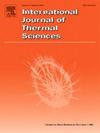Thermal-resistance modeling of free convection in metal foam for electronics cooling
IF 4.9
2区 工程技术
Q1 ENGINEERING, MECHANICAL
International Journal of Thermal Sciences
Pub Date : 2025-03-29
DOI:10.1016/j.ijthermalsci.2025.109901
引用次数: 0
Abstract
Metal foams have been investigated for both forced and free convection heat transfer applications. However, there appear to be no engineering models for determining the thermal resistance of metal foams when used in free convection. In this paper, a new engineering model is presented to fill this gap. The model is developed from first principles of heat transfer and the concept of thermal resistance network. It identifies the various resistances present inside the foam, and the associated temperature difference for each resistance. A few coefficients were needed to calibrate the model, and they were determined from experimental data on an actual aluminum foam sample having 20 pores per inch (ppi) and a porosity of 76.4 %. The dimensions of the foam sample were 109 mm by 110 mm by 20 mm. The sample was subjected to three heat fluxes: 884.1 W/m2, 1217.7 W/m2 and 1884.9 W/m2, and was cooled by room air. Subsequently, the model of the thermal resistance of the foam was validated by further experiments on three foam samples having different materials and morphological properties. These samples included aluminum and copper foam, and had porosities in the range 74.5 %–78.0 %. There was very good agreement between the thermal resistances of the foam as predicted by the model and their experimental counterparts. The heated wall temperature was predicted by the model within reasonable error. The model allows optimization of metal foam in terms of pore density and porosity for free convection. The model also shows that no advantage is gained by using copper foam as opposed to aluminum foam for passive cooling.
电子冷却用金属泡沫中自由对流的热阻建模
研究了金属泡沫在强制对流和自由对流传热中的应用。然而,似乎没有工程模型来确定金属泡沫在自由对流中使用时的热阻。本文提出了一种新的工程模型来填补这一空白。该模型由传热第一原理和热阻网络的概念发展而来。它确定了泡沫内部存在的各种电阻,以及每个电阻的相关温差。校准模型需要几个系数,这些系数是根据实际泡沫铝样品的实验数据确定的,该样品每英寸(ppi)有20个孔,孔隙率为76.4%。泡沫试样的尺寸为109 mm × 110 mm × 20 mm。样品承受了884.1 W/m2、1217.7 W/m2和1884.9 W/m2三种热流密度,并通过室内空气冷却。随后,通过对三种不同材料和形态的泡沫试样进行进一步实验,验证了泡沫的热阻模型。这些样品包括铝和铜泡沫,孔隙率在74.5% - 78.0%之间。模型预测的泡沫材料的热阻与实验结果吻合较好。该模型预测的加热壁温度在合理的误差范围内。该模型允许优化金属泡沫的孔隙密度和孔隙率的自由对流。该模型还表明,与使用泡沫铝相比,使用泡沫铜进行被动冷却没有任何优势。
本文章由计算机程序翻译,如有差异,请以英文原文为准。
求助全文
约1分钟内获得全文
求助全文
来源期刊

International Journal of Thermal Sciences
工程技术-工程:机械
CiteScore
8.10
自引率
11.10%
发文量
531
审稿时长
55 days
期刊介绍:
The International Journal of Thermal Sciences is a journal devoted to the publication of fundamental studies on the physics of transfer processes in general, with an emphasis on thermal aspects and also applied research on various processes, energy systems and the environment. Articles are published in English and French, and are subject to peer review.
The fundamental subjects considered within the scope of the journal are:
* Heat and relevant mass transfer at all scales (nano, micro and macro) and in all types of material (heterogeneous, composites, biological,...) and fluid flow
* Forced, natural or mixed convection in reactive or non-reactive media
* Single or multi–phase fluid flow with or without phase change
* Near–and far–field radiative heat transfer
* Combined modes of heat transfer in complex systems (for example, plasmas, biological, geological,...)
* Multiscale modelling
The applied research topics include:
* Heat exchangers, heat pipes, cooling processes
* Transport phenomena taking place in industrial processes (chemical, food and agricultural, metallurgical, space and aeronautical, automobile industries)
* Nano–and micro–technology for energy, space, biosystems and devices
* Heat transport analysis in advanced systems
* Impact of energy–related processes on environment, and emerging energy systems
The study of thermophysical properties of materials and fluids, thermal measurement techniques, inverse methods, and the developments of experimental methods are within the scope of the International Journal of Thermal Sciences which also covers the modelling, and numerical methods applied to thermal transfer.
 求助内容:
求助内容: 应助结果提醒方式:
应助结果提醒方式:


